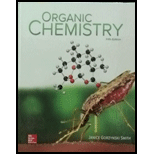
Concept explainers
(a)
Interpretation: The
Concept introduction: The inscribed polygon method is helpful to predict whether a compound involves completely filled bonding
(b)
Interpretation: The arrangement of electrons in the
Concept introduction: The inscribed polygon method is helpful to predict whether a compound involves completely filled bonding
(c)
Interpretation: The number of
Concept introduction: The inscribed polygon method is helpful to predict whether a compound involves completely filled bonding
(d)
Interpretation: The arrangement of
Concept introduction: The inscribed polygon method is helpful to predict whether a compound involves completely filled bonding
(e)
Interpretation: The classification of dianion as aromatic, nonaromatic, or antiaromatic is to be stated and its being so is to be explained.
Concept introduction: The inscribed polygon method is helpful to predict whether a compound involves completely filled bonding
Trending nowThis is a popular solution!

Chapter 17 Solutions
ORGANIC CHEMISTRY-W/ACCESS >CUSTOM<
- Could you explain why the highlighted group on the right side of the double bond has a higher priority than the lower group on the right side of the double bond. I use this information to determine E/Z assigmentsarrow_forwardThe Diels–Alder reaction, a powerful reaction discussed in Chapter 14, occurs when a 1,3-diene such as A reacts with an alkene such as B to form the six-membered ring in C. a.Draw curved arrows to show how A and B react to form C. b.What bonds are broken and formed in this reaction? c.Would you expect this reaction to be endothermic or exothermic? d.Does entropy favor the reactants or products? e. Is the Diels–Alder reaction a substitution, elimination, or addition?arrow_forward#6). Second picture shows instructions on how the arrows must be shown as.arrow_forward
- why is cyclopentadiene more acidic than cycloheptatriene?arrow_forwardResveratrol is an antioxidant found in the skin of red grapes. Its anticancer, anti-inflammatory, and various cardiovascular effects are under active investigation. (a) Draw all resonance structures for the radical that results from homolysis of the OH bond shown in red. (b) Explain why homolysis of this OH bond is preferred to homolysis of either OH bond in the other benzene ring.arrow_forwardDraw the product and include lone pairs of electronsarrow_forward
- a. How many s bond orbitals are available for overlap with the vacant p orbital in 1. the isobutyl cation? 2. the n-butyl cation? 3. the sec-butyl cation? b. Which of the carbocations in part a is most stable?arrow_forwardGiven the data, find the specific heat of part A; Heat of Reaction 1 (ΔH1) of part B; Heat of Reaction 2 (ΔH2) of part C; Heat of Reaction 3 (ΔH3) of part D .arrow_forward(a) Draw a Kekulé structure that shows how the reactive positions of anthracene are the ends of a diene, appropriate for a Diels–Alder reaction.(b) The Diels–Alder reaction of anthracene with maleic anhydride is a common organic lab experiment. Predict the product of this Diels–Alder reaction.arrow_forward
 Organic Chemistry: A Guided InquiryChemistryISBN:9780618974122Author:Andrei StraumanisPublisher:Cengage Learning
Organic Chemistry: A Guided InquiryChemistryISBN:9780618974122Author:Andrei StraumanisPublisher:Cengage Learning

